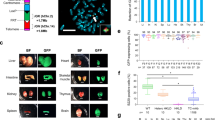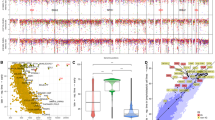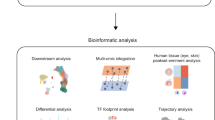Abstract
A functional immunoglobulin gene is formed by the fusion of individual coding elements which are widely separated in germ-line DNA. For the mouse κ light chain gene, this is accomplished by DNA rearrangement which brings one of a large repertoire of non-allelic variable region (Vκ) genes into apposition with one of four junctional (Jκ) elements located 2.7–3.9 kilobases (kb) upstream from the κ constant region coding sequence (Cκ)1–4. Transcription is initiated near the 5′ end of the rearranged Vκ locus, and spans all three coding elements and the large intervening sequence between Jκ and Cκ, and a smaller intervening sequence within the Vκ gene5. Little is known of the mechanisms which control the expression of rearranged immunoglobulin genes. We have studied the process of κ light chain gene activation in a mouse leukaemia cell line, 70Z/3, which synthesizes a κ-type light chain protein in response to bacterial lipopolysaccharide (LPS). Here we describe changes in the chromatin structure of the κ genes occurring as a result of LPS treatment, and present evidence that a discrete region located inside the large intervening sequence of the κ transcription unit plays a part in κ gene activation.
This is a preview of subscription content, access via your institution
Access options
Subscribe to this journal
Receive 51 print issues and online access
$199.00 per year
only $3.90 per issue
Buy this article
- Purchase on SpringerLink
- Instant access to full article PDF
Prices may be subject to local taxes which are calculated during checkout
Similar content being viewed by others
References
Brack, C., Hirama, M., Lenhard-Schuller, R. & Tonegawa, S. Cell 15, 1–14 (1978).
Seidman, J. G. & Leder, P. Nature 276, 790–795 (1978).
Early, P. W., Davies, M. M., Kaback, D. B., Davidson, N. & Hood, L. Proc. natn. Acad. Sci. U.S.A. 76, 857–861 (1979).
Max, E. E., Seidman, J. G. & Leder, P. Proc. natn. Acad. Sci. U.S.A. 76, 3450–3454 (1979).
Perry, R. P. et al. Proc. natn. Acad. Sci. U.S.A. 77, 1937–1941 (1980).
Paige, C. J., Kincade, P. W. & Ralph, P. J. Immun. 121, 641–647 (1978).
Paige, C. J., Kincade, P. W. & Ralph, P. Nature 292, 631–633 (1981).
Maki, R., Kearney, J., Paige, C. J. & Tonegawa, S. Science 209, 1366–1369 (1980).
Perry, R. P. & Kelley, D. E. Cell 18, 1333–1339 (1979).
Parslow, T. G. & Granner, D. K. (in preparation).
Mather, E. L. & Perry, R. P. Nucleic Acids Res. 9, 6855–6867 (1981).
Storb, U., Wilson, R., Selsing, E. & Walfield, A. Biochemistry 20, 990–996 (1981).
Perry, R. P., Kelley, D. E., Coleclough, C. & Kearney, J. F. Proc. natn. Acad. Sci. U.S.A. 78, 247–251 (1981).
Van Ness, B. G. et al. Cell 27, 593–602 (1981).
Selsing, E. & Storb, U. Cell 25, 47–58 (1981).
Choi, E., Kuehl, M. & Wall, R. Nature 286, 776–779 (1980).
Seidman, J. G. & Leder, P. Nature 286, 779–783 (1980).
Heiter, P. A., Max, E. E., Seidman, J. G., Maizel, J. V. & Leder, P. Cell 22, 197–207 (1980).
Stalder, J. et al. Cell 20, 451–460 (1980).
Groudine, M. & Weintraub, H. Cell 24, 393–401 (1981).
Keene, M. A., Corces, V., Lowenhaupt, K. & Elgin, S. C. R. Proc. natn. Acad. Sci. U.S.A. 78, 143–146 (1981).
Samal, B., Worcel, A., Louis, C. & Schedl, P. Cell 23, 401–409 (1981).
Wu, C. & Gilbert, W. Proc. natn. Acad. Sci. U.S.A. 78, 1577–1580 (1981).
Storb, U., Arp, B. & Wilson, R. Nature 294, 90–92 (1981).
Elgin, S. C. R. Cell 27, 413–415 (1981).
Thomas, P. S. Proc. natn. Acad. Sci. U.S.A. 77, 5201–5205 (1980).
Jackson, V. & Chalkley, R. Biochemistry 13, 3952–3956 (1974).
Smith, G. E. & Summers, M. D. Analyt. Biochem. 109, 123–129 (1980).
Rigby, P. W. J., Dieckmann, M., Rhodes, C. & Berg, P. J. molec. Biol. 113, 237–251 (1977).
Schwartz, R. C., Sonenshein, G. E., Bothwell, A. & Gefter, M. L. J. Immun. 126, 2104–2108 (1981).
Kioussis, D. et al. Proc. natn. Acad. Sci. U.S.A. 76, 4370–4374 (1979).
Parslow, T. G., Murphy, W., Katzen, C. & Granner, D. K. (in preparation).
Author information
Authors and Affiliations
Rights and permissions
About this article
Cite this article
Parslow, T., Granner, D. Chromatin changes accompany immunoglobulin κ gene activation: a potential control region within the gene. Nature 299, 449–451 (1982). https://doi.org/10.1038/299449a0
Received:
Accepted:
Issue date:
DOI: https://doi.org/10.1038/299449a0
This article is cited by
-
DNA sequence patterns in human, mouse, and rabbit immunoglobulin kappa-genes
Journal of Molecular Evolution (1985)
-
Evidence for chromatin structure as a regulatory determinant in HLA-DR ?gene expression
Immunogenetics (1985)
-
A lymphocyte-specific enhancer in the mouse immunoglobulin κ gene
Nature (1984)
-
Variant (6 ; 15) translocation in a murine plasmacytoma occurs near an immunoglobulin κ gene but far from the myc oncogene
Nature (1984)
-
Expression of a microinjected immunoglobulin gene in the spleen of transgenic mice
Nature (1983)



